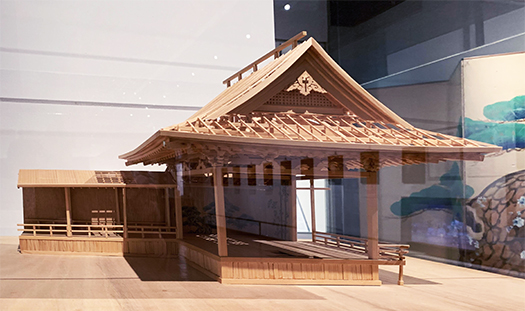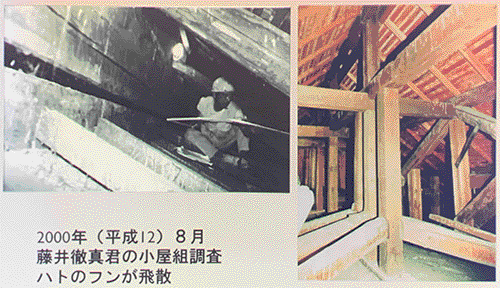


さて北海道に残る総合芸術建築・岡崎家能舞台を見て来ました。
1925年(大正14年)創建という建築なのでほぼ100年。
創建から60年後の1985年には「小樽市歴史的建造物」に指定される。
という経緯があって、1999年には駒木先生の力で
北海道職業能力開発大学校建築科による実測調査が2年かけて行われた。
2枚目の写真はそのときに小屋裏部分に入ったところの様子。
当時すでに大工職人であった藤井徹真くんの活躍ぶりです。
駒木先生のお話では何度も行われた実測調査活動で最後まですべて参加したのは
実はかれひとりだったという情報開示も行われていました。
大工仕事を実際にしながら木造技術を極めたいと学んでいたということ。
こういう伝統的建築は当然、長期保存優先志向で材の乾燥のために
隙間だらけの作り方になる。
現代の高断熱高気密技術では密閉と乾燥のための開放は
同時に解決するように技術進化しているけれど、
伝統的技術ではこういう作り方になる。したがって小屋裏内部は
野生の鳥、ハトなどが内部に入り込んで雨天などのときに恰好の巣になる。
いきおい大量のフンが集積することになる(!)。
構造を解明するためにはそのフンを除去する必要がある。
まことに奮闘努力の賜物であります。
屋根の木造構造があらわになって右側写真のようにタテの柱材に対して
放射状に梏木〜はねき〜という材が渡されている様子も実測された。
このような地道な実測作業によって先人の営為を確認することは
技術の伝承の基盤を確立することにつながる。
そういう成果を模型として造作したのが1番目の展示写真。
また、3枚目の写真は解体組立式の能舞台の説明模型。
今回の駒木先生の講演に続けてこちらの説明もされていました。
現代の木造技術者のみなさんによる技術の解析、伝承努力の一端が知れた。
とくに床面は一般住宅とは目的が違うので床の音響効率を考え
板面を太鼓の表面皮革のように造作している。
より本格的な能舞台ではこの音響効率をさらに高めるために
床下に半分埋め込んで大きな壷が複数配置されている。
能や狂言では役者の足による太鼓効果や、笛や太鼓の伴奏具の音響などが
囲んでいる客席に対して響き渡るように空間デザインされる。
そういう建築の仕立ての技術が解明されていくのですね。
このようにして建築の側では伝承努力がされているけれど、
それを活用し能狂言のような日本文化の粋を北海道に根付かせるには
北のくらし文化の進化発展が同時に求められる。
今日社会の究極的な個人主義傾向のなかで日本社会と文化の揺りかご、
伝統的なムラ共同体の共存共栄意識は極小化傾向というしかない。
全世界的な傾向と言われる人口減少の問題とも通底する。
日本社会がムラ共同体の柔軟性に再び目覚めることが必要なのではないかと
深く思い知らされるのでありますが、さて・・・。
English version⬇
Efforts to Inherit Wooden Construction Techniques: The “Noh Stage” in Otaru – 4
In order to revitalize the Noh stage, we are analyzing its structure and making it inheritable. The technology has been accepted, but society has undergone a major structural change. What about cultural inheritance? Well, what about cultural inheritance?
I visited the Okazaki Family Noh Stage, a comprehensive art architecture remaining in Hokkaido.
It was built in 1925, so it is almost 100 years old.
In 1985, 60 years after its construction, it was designated as an “Otaru City Historical Building.
In 1999, the building was designated as a “Historical Building of Otaru City” by the
In 1999, a survey was conducted by the architectural department of the Hokkaido Vocational Ability Development College over a period of two years.
The second photo is a view of the back part of the shed at that time.
Tetsuma Fujii, who was already a carpenter craftsman at the time, was very active.
Mr. Komaki told us that he was the only one who participated in all of the surveying activities that took place until the end.
He also disclosed that he was the only one who participated in all of the surveying activities that took place.
He had learned to master wooden construction techniques while actually working as a carpenter.
Naturally, this kind of traditional architecture is built with a priority on long-term preservation.
The building is full of gaps and crevices.
With today’s highly insulated and airtight technology, sealing and opening for drying have evolved to be solved at the same time.
and open for drying at the same time.
traditional techniques are based on this method of construction. Therefore, the interior of the back of the house is
wild birds, pigeons, etc., enter the interior and make a good nest when it rains.
This leads to the accumulation of a large amount of feces (!). The structure of the hut is not yet understood.
In order to clarify the structure, it is necessary to remove the feces.
This is the result of a great deal of hard work and effort.
The wooden structure of the roof is revealed, and as shown in the photo on the right, the vertical columns are surrounded by handcuffs and splintered wood.
As shown in the photo on the right, the wooden structure of the roof was revealed, and the way the handcuffs were radially attached to the vertical columns was also measured.
Confirming the activities of our predecessors through this kind of diligent measurement work is a great way to establish a foundation for the transmission of technology.
This kind of work is the foundation for the transmission of technology.
The first photo shows a model of the results of this work.
The third photo is an explanatory model of a disassembled and reassembled Noh stage.
This explanation was given following Dr. Komaki’s lecture this time.
I was able to learn about some of the efforts made by modern wood construction engineers to analyze and hand down their techniques.
In particular, the purpose of the floor surface is different from that of an ordinary house, so the acoustic efficiency of the floor was considered.
The wooden planks are made to look like the surface leather of a drum.
In order to further improve the acoustic efficiency of a full-fledged Noh stage, a large urn is half embedded under the floor.
the floor to further enhance the acoustic efficiency of the Noh stage.
In Noh and Kyogen plays, the drumming effect of the actors’ feet and the sound of the accompanying instruments such as flutes and drums
The space is designed so that the drumming effect of the actor’s feet and the sound of the flutes and drums echoes out to the surrounding audience.
This kind of architectural tailoring technique is being elucidated.
In this way, efforts are being made on the architectural side to pass on the traditions of Noh theater.
However, in order to utilize these techniques and to establish the best of Japanese culture, such as Noh and Kyogen, in Hokkaido, it is essential that the evolution and development of the northern lifestyle culture be promoted.
The evolution and development of northern lifestyle culture is required at the same time.
In the midst of today’s society’s ultimate trend toward individualism, the cradle of Japanese society and culture, the traditional mura community, must coexist.
The coexistence and co-prosperity of the traditional mura community, the cradle of Japanese society and culture, has become a trend toward minimization.
This is also the same as the problem of declining population, which is said to be a global trend.
It is necessary for Japanese society to reawaken to the flexibility of the mura community.
I am deeply reminded of this…
Posted on 6月 10th, 2022 by 三木 奎吾
Filed under: 住宅マーケティング, 日本社会・文化研究







コメントを投稿
「※誹謗中傷や、悪意のある書き込み、営利目的などのコメントを防ぐために、投稿された全てのコメントは一時的に保留されますのでご了承ください。」
You must be logged in to post a comment.